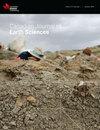Petrogenesis and metallogenic implications of Eocene–Oligocene magmatism in the Yulong porphyry copper belt, eastern Tibet: A review and analysis of geochronological, geochemical and Sr–Nd–Pb–Hf isotopic data
IF 1.6
4区 地球科学
Q3 GEOSCIENCES, MULTIDISCIPLINARY
引用次数: 0
Abstract
The Eocene Yulong porphyry copper belt in eastern Tibet contains more than 10 Mt of Cu metal, associated with subvolcanic to volcanic porphyry systems intruding Cenozoic sedimentary basins. Geochemical data analysis shows that all samples belonged to high-K calc-alkaline and shoshonite series with metaluminous–peraluminous characteristics, light rare earth elements and large ion lithophile elements enrichment, high field strength elements depletion, and share geochemical similarities to adakitic rocks. We have established a spatiotemporal evolution framework through geochronological data analysis, combined with calculated bulk zirconium saturation temperature, calculated crustal thickness and geophysical evidence. We identified three magmatic processes triggered by asthenospheric upwelling and thermal erosion of thickened crust: (1) ultrapotassic magma derived from metasomatized mantle; (2) coeval ultrapotassic melt which promoted the partial melting of eroded lower crust and the generation of high-K adakitic felsic melt; high-K and Mg# adakitic fertile magma was formed by interaction between the eroded sulphide-rich juvenile lower crust-derived melt and mantle peridotite; (3) high-K adakitic fertile magma was derived from sulphide-rich juvenile lower crust, triggered by injecting hydrous ultrapotassic magma into thinned lower crust. The difference between deposit size in the North/South section of Yulong belt may be caused by the temperature of magmatic source and the volume of coeval potassic–ultrapotassic magmatism. Our analysis of the YPCB suggests that magmatism after 175 Ma within Intermontane arc complex of the Canadian Cordillera has high potential for porphyry deposits.藏东玉龙斑岩铜带始新统—渐新统岩浆成因及成矿意义:年代学、地球化学及Sr-Nd-Pb-Hf同位素资料回顾与分析
藏东始新世玉龙斑岩铜带含铜量超过10 Mt,与侵入新生代沉积盆地的次火山—火山斑岩体系有关。地球化学数据分析表明,所有样品均属于高钾钙碱性和软顺石系列,具有金属-过铝特征,轻稀土元素和大离子亲石元素富集,高场强元素亏缺,与埃达克质岩石具有地球化学相似性。通过年代学数据分析,结合计算体锆饱和温度、计算地壳厚度和地球物理证据,建立了时空演化框架。在软流圈上升流和增厚地壳热侵蚀作用下,确定了3个岩浆过程:(1)变质地幔引发的超晚叠世岩浆;(2)同时期的超古典纪熔体促进了侵蚀下地壳的部分熔融和高钾埃达克质长英质熔体的生成;富硫化物的下壳源熔融体与地幔橄榄岩相互作用形成高钾镁质富岩浆;(3)高钾埃达奇质富硫岩浆来源于富硫化物的下地壳幼期岩浆,是由含水超纯岩浆注入变薄的下地壳引发的。玉龙带南北段矿床规模的差异可能是岩浆源温度和同时期钾—超古生代岩浆活动体积的差异所致。分析表明,加拿大科迪勒拉山间弧杂岩175 Ma以后的岩浆活动具有较高的斑岩矿床潜力。
本文章由计算机程序翻译,如有差异,请以英文原文为准。
求助全文
约1分钟内获得全文
求助全文
来源期刊

Canadian Journal of Earth Sciences
地学-地球科学综合
CiteScore
2.80
自引率
7.10%
发文量
66
审稿时长
6-12 weeks
期刊介绍:
The Canadian Journal of Earth Sciences reports current research in climate and environmental geoscience; geoarchaeology and forensic geoscience; geochronology and geochemistry; geophysics; GIS and geomatics; hydrology; mineralogy and petrology; mining and engineering geology; ore deposits and economic geology; paleontology, petroleum geology and basin analysis; physical geography and Quaternary geoscience; planetary geoscience; sedimentology and stratigraphy; soil sciences; and structural geology and tectonics. It also publishes special issues that focus on information and studies about a particular segment of earth sciences.
 求助内容:
求助内容: 应助结果提醒方式:
应助结果提醒方式:


